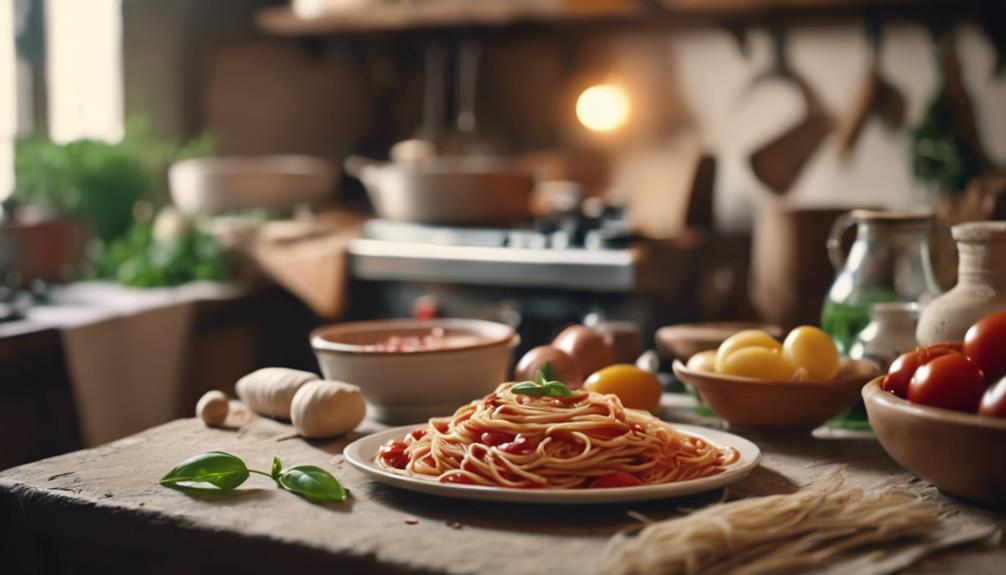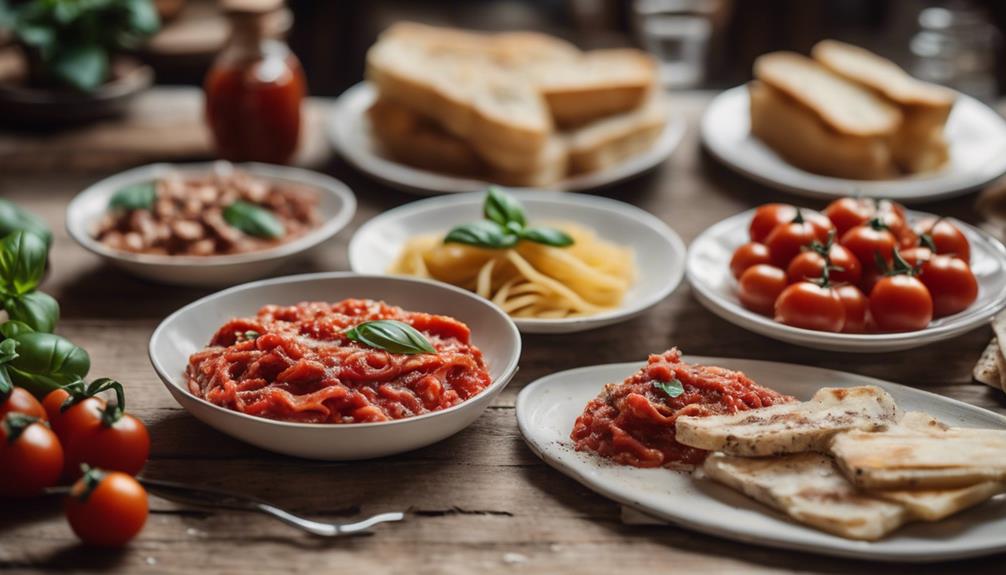If you’re looking to enjoy authentic Italian cuisine, treat yourself to a delightful selection of traditional favorites. From classic Pizza Napoletana to indulgent Lasagna, Italy’s culinary traditions will surely satisfy your palate. Discover a variety of pasta shapes, creamy Risotto, and hearty soups like Ribollita. Indulge in regional seafood specialties and iconic desserts such as Tiramisu and Italian Gelato. Antipasti platters filled with marinated vegetables, meats, and cheeses are perfect for sharing. Those with a craving for meat dishes will find rustic Italian flavors to delight in. The timeless recipes for risotto and essential gelato flavors are just the beginning of your flavorful journey.
Key Takeaways
- Authentic Italian dishes include Pizza Napoletana, Margherita pizza, classic pasta dishes, iconic soups, and regional seafood specialties.
- Traditional Italian antipasti feature marinated vegetables, olives, cured meats, cheeses, seafood, and bruschetta.
- Rustic Italian meat dishes are known for rich flavors, slow cooking methods, regional variations, and the use of fresh herbs and wine.
- Timeless Italian risotto recipes use butter, onion, white wine, Parmesan cheese, and Arborio rice with regional twists for unique flavors.
- Essential Italian gelato flavors include Pistachio, Hazelnut, Stracciatella, Lemon, and Tiramisu, influenced by Sicilian culture.
Traditional Italian Pizza Varieties
Exploring the diverse world of traditional Italian pizza varieties will uncover a rich tapestry of regional flavors and styles. One of the most iconic and beloved is the pizza Napoletana, originating in Naples. This authentic Italian pizza is known for its thin, soft crust and simple yet flavorful toppings. Among these toppings is the famous Margherita pizza, named after Queen Margherita of Savoy, who tried it in 1889. This classic pizza features the colors of the Italian flag with tomatoes, mozzarella, and basil.
When delving into the domain of traditional Italian pizzas, you'll encounter a myriad of unique regional styles such as Roman, Sicilian, and Neapolitan. Each style boasts its own distinct characteristics and ingredients, showcasing the culinary diversity of Italy.
From the crispy crust of a Roman pizza to the thick, rectangular slice of a Sicilian pie, the variety of traditional Italian pizzas is truly a feast for both the eyes and the taste buds.
Classic Pasta Dishes
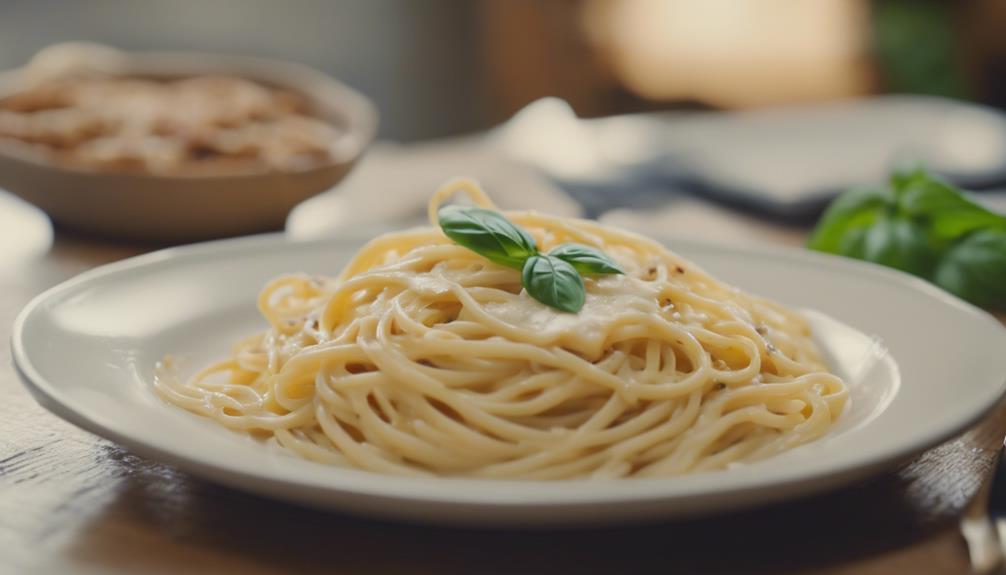
Explore the delectable world of classic pasta dishes, a staple of Italian cuisine that showcases the versatility and creativity of regional flavors. Pasta, with its origins in Sicily, has woven its way through various Italian regions, crafted from durum wheat and often enriched with eggs. The Italian pasta dishes offer a canvas for countless toppings, coming in an array of shapes and sizes to delight your taste buds.
One must mention the iconic classics when discussing pasta in Italian cuisine. Take, for example, the beloved lasagna, a baked delight boasting layers of pasta intertwined with rich tomato-based sauces, complemented by savory fillings like beef, pork, and cheese.
Ravioli, another pasta marvel, comes in endless variations across Italy, with pasta envelopes embracing sumptuous fillings like meats, ricotta, cheeses, vegetables, or seafood. And let's not forget risotto, a creamy Northern Italian dish that simmers rice pasta in broth to create a comforting masterpiece featuring ingredients like cheese and vegetables.
Immerse yourself in the world of classic Italian pasta dishes, where tomato sauce reigns supreme!
Iconic Italian Soups and Stews
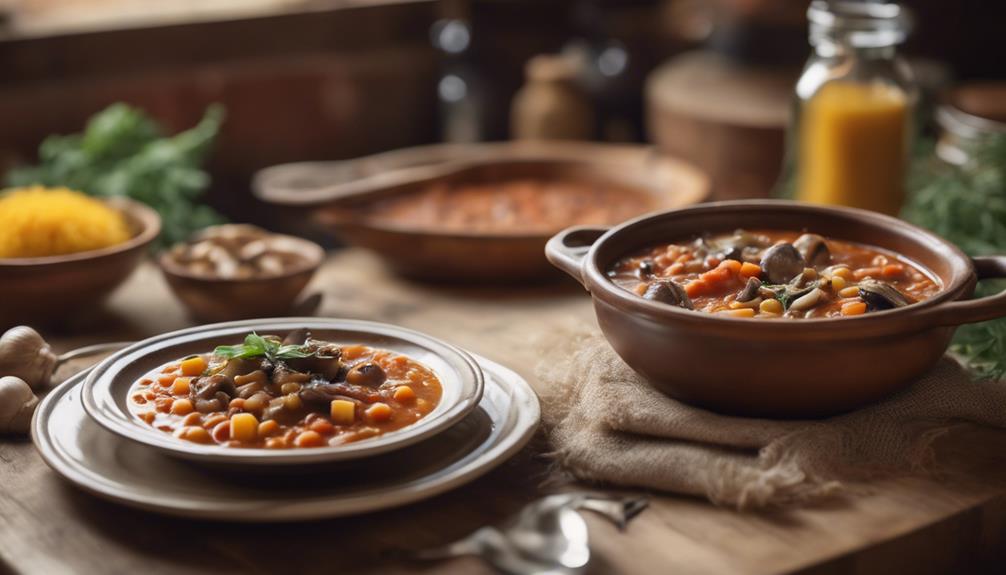
Discover the richness of flavor and tradition in iconic Italian soups and stews, a comforting culinary journey through Italy's diverse regions. When it comes to Italian soups and stews, authenticity is key. Here are some must-try dishes to experience the true essence of traditional Italian cuisine:
- Ribollita Soup: A hearty Tuscan favorite, this soup combines day-old bread and bean mash for a gluten-free twist that will warm your soul.
- Garlic-Sautéed Shrimp: This versatile Italian dish can be enjoyed as a stand-alone appetizer or as a flavorful pasta topping. The quick stock adds depth to the dish, making it a crowd-pleaser.
- Brodetto di Pesce: Along the Adriatic coast, this seafood stew reigns supreme. Made with fresh fish and served with grilled or toasted bread, it's a taste of the sea in every spoonful.
Immerse yourself in the delicious world of Italian soups and stews, where each spoonful tells a story of tradition and flavor.
Regional Italian Seafood Specialties

When it comes to regional Italian seafood specialties, get ready to tantalize your taste buds with unique sea treasures and coastal culinary delights.
From the Adriatic-style seafood stew, Brodetto di Pesce, to the versatile garlic-sautéed shrimp that can jazz up any pasta dish, Italy offers a seafood feast like no other.
With dishes like herb-crusted Mediterranean Sea Bass and the tradition of featuring an array of seafood in Christmas Eve dinners, Italian cuisine will surely make waves on your palate.
Unique Seafood Traditions
Explore the rich tapestry of flavors and culinary traditions found in regional Italian seafood specialties along the stunning coastlines of Italy. When it comes to unique seafood traditions, Italian cuisine shines with a variety of mouthwatering options:
- Seafood Stew: Brodetto di Pesce, a popular Adriatic-style seafood stew, is a delightful dish served along the coast. Made with fresh fish and accompanied by grilled bread, this stew brings together a symphony of flavors from the sea.
- Garlic-Sautéed Shrimp: Versatile and flavorful, garlic-sautéed shrimp is a crowd-pleaser. Whether served as an appetizer or paired with pasta, this dish is elevated by a quick stock that enhances its depth of flavor.
- Sea Bass: Herb-crusted Mediterranean sea bass is a simple yet elegant choice. Highlighting the natural taste of the sea bass with buttery breadcrumbs and herbs, this dish is a true delight for seafood lovers.
Italian seafood dishes are known for their emphasis on fresh, quality ingredients that bring out the best of the sea, making each bite a culinary experience to remember.
Coastal Culinary Delights
Exploring the coastal culinary delights of regional Italian seafood specialties reveals a vibrant array of flavors and traditions that encapsulate the essence of Italy's seaside gastronomy. Italian coastal cuisine boasts a rich tapestry of dishes, from the hearty Brodetto di Pesce, a seafood stew brimming with the catch of the day and served with crispy grilled bread, to the zesty Garlic-Sautéed Shrimp, where succulent shrimp are bathed in a flavorful quick stock.
The Herb-Crusted Mediterranean Sea Bass stands out as a simple yet delectable dish that celebrates the delicate taste of the sea bass, enhanced by buttery breadcrumbs and aromatic Mediterranean herbs. Coastal regions in Italy take pride in their fresh seafood offerings, with specialties like Brodetto di Pesce and Garlic-Sautéed Shrimp embodying the essence of the sea.
Each bite of these coastal delights transports you to the sun-kissed shores of Italy, where the bounty of the sea is transformed into culinary masterpieces that honor tradition while embracing innovation in seafood preparation.
Famous Italian Desserts

Discover the delectable world of famous Italian desserts that tantalize taste buds with their rich flavors and cultural heritage. From the iconic Tiramisu, originating from the Veneto region, to the chewy Italian Hazelnut Cookies, there's a sweet treat for every palate.
Let's not forget the savory twist with Gnocchi with Truffle Parmesan Sauce, a dish that combines the richness of truffle oil with a creamy Parmesan sauce for a truly magical experience.
- Tiramisu is a beloved classic, with its layers of coffee-infused biscuits and velvety mascarpone.
- Italian Hazelnut Cookies, known as Brutti ma Buoni, offer a delightful nutty flavor and chewy texture that are hard to resist.
- Gnocchi with Truffle Parmesan Sauce, a creation by the esteemed Fabio Viviani, elevates the humble potato dumplings with the luxurious touch of truffle oil in a decadent Parmesan sauce.
Indulge in these desserts that not only satisfy your sweet tooth but also celebrate the rich heritage of Italian culinary traditions.
Authentic Italian Antipasti
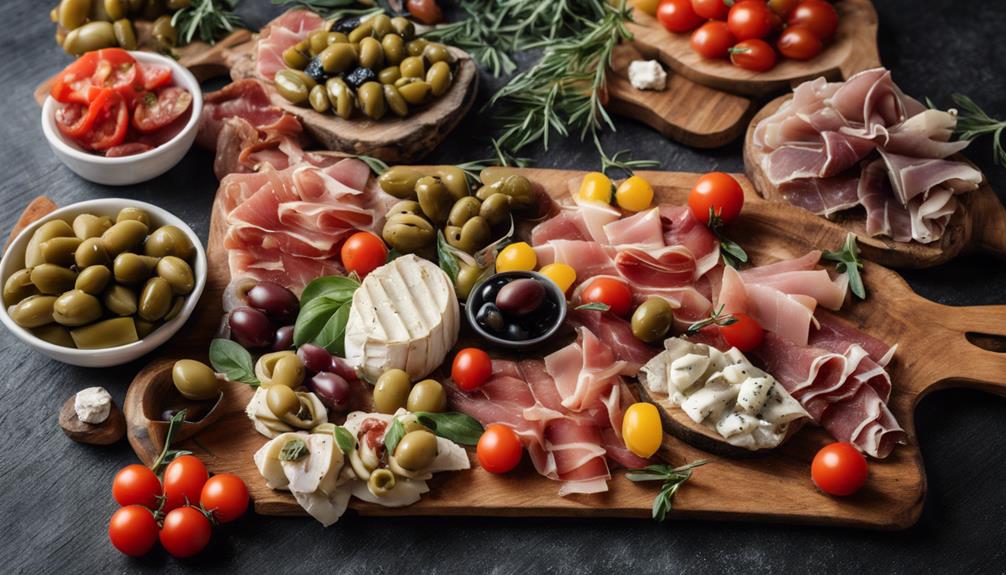
Hey there, ready to tantalize your taste buds with some authentic Italian antipasti?
These traditional appetizers are bursting with flavor and showcase the diversity of Italian cuisine.
From savory cured meats to tangy marinated vegetables, antipasti are the perfect way to kick off a delicious meal.
Traditional Antipasti Ingredients
Traditional antipasti ingredients in authentic Italian cuisine often include a delightful array of cured meats, olives, cheeses, and marinated vegetables. When indulging in these tantalizing appetizers, you'll likely encounter:
- Cured Meats: Prosciutto and salami are common stars of the antipasti platter, offering savory, rich flavors that pair perfectly with other ingredients.
- Cheeses: Parmigiano Reggiano, a beloved Italian cheese, often makes an appearance alongside other varieties like pecorino or mozzarella, adding a creamy and tangy contrast.
- Marinated Vegetables: Artichokes, peppers, and mushrooms are often marinated to infuse them with zesty flavors, providing an invigorating and tangy bite to complement the meats and cheeses.
These ingredients not only awaken your taste buds but also showcase the culinary expertise and diverse flavors that define Italian cuisine.
Regional Antipasti Variations
Explore the diverse regional variations of authentic Italian antipasti, each offering a unique culinary experience that reflects the distinct flavors and traditions of the area.
Italian cuisine is renowned for its rich diversity, and antipasti are no exception. In Southern Italy, antipasto often boasts a delightful array of olives, savory cured meats, and an assortment of cheeses that tantalize the taste buds.
On the other hand, Northern Italian antipasti might showcase a more seafood-centric selection, alongside pickled vegetables and crispy crostini.
Central Italy brings its own twist to the table with bruschetta, artichokes, and of course, more delicious cured meats.
These regional specialties not only serve as appetizers but also as a representation of the local culinary heritage. The careful selection of ingredients and preparation methods encapsulate the essence of each region, making antipasti a delightful introduction to any traditional Italian meal.
Serving Antipasti Etiquette
Enhance your dining experience by mastering the proper etiquette for serving authentic Italian antipasti. When indulging in this traditional Italian cuisine, remember these key points to fully appreciate the experience:
- Communal Dining: Embrace the Italian spirit of communal dining by serving antipasti on shared platters. This encourages interaction and creates a convivial atmosphere around the table.
- Room Temperature: Allow the flavors of the antipasti to shine by serving them at room temperature. This guarantees that the richness of the cured meats, cheeses, olives, pickled vegetables, and bruschetta is fully enjoyed.
- Aperitif Pairing: Complement your antipasti with a glass of wine or an aperitif before the main course. This not only enhances the flavors but also sets the tone for a delightful dining experience.
Rustic Italian Meat Dishes
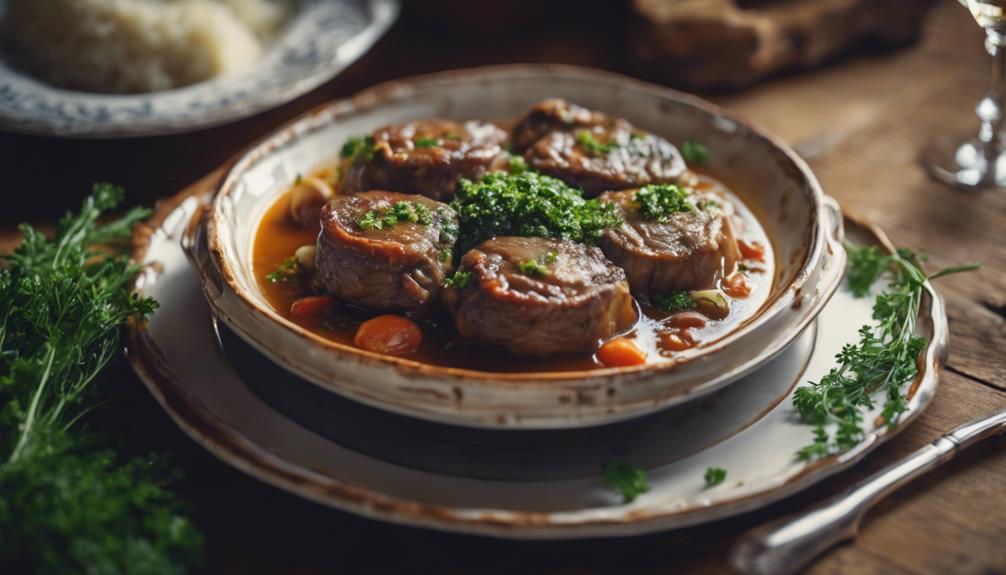
When it comes to Rustic Italian Meat Dishes, you can expect a delightful blend of rich flavors and hearty ingredients that showcase the essence of traditional Italian cuisine. From meat sauce to Italian Sausage, dishes like Bolognese and beef-based creations are staples that have stood the test of time. The secret lies in the slow cooking methods that allow the flavors to deepen and the meats to become tender, resulting in dishes that are bursting with savory goodness.
Italian meat dishes are a true reflection of regional variations, each offering a unique twist on classic recipes. Whether it's the Osso Buco from Milan, Pollo alla Cacciatora from Tuscany, or Brasato al Barolo from Piedmont, there's a dish for every meat lover. Fresh herbs, tomatoes, wine, and cheese are commonly used ingredients that add layers of complexity to these rustic dishes, making them a true delight for the senses.
Timeless Italian Risotto Recipes
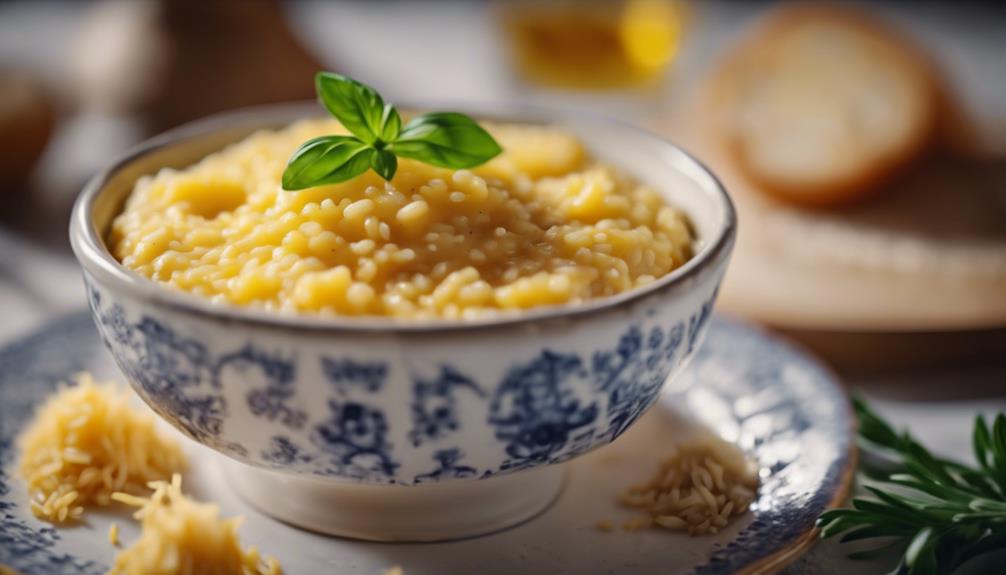
For an authentic taste of Italy that's both comforting and flavorful, let's now discover the world of Timeless Italian Risotto Recipes.
- Risotto Origin: Risotto, a classic Italian recipe, originated in Northern Italy. It's a creamy rice dish cooked in broth until it reaches a rich, velvety consistency.
- Traditional Ingredients: Authentic Italian risotto often features butter, onion, white wine, Parmesan cheese, and Arborio rice, creating a harmonious blend of flavors and textures.
- Regional Varieties: From the vibrant Risotto Milanese with saffron to the rich Risotto alla Parmigiana with Parmesan cheese or the earthy Risotto ai Funghi with mushrooms, different Italian regions offer unique twists on this beloved dish.
Each bite of these timeless risotto recipes brings you closer to the heart of Italy, where tradition and innovation meet to create dishes that have stood the test of time.
Enjoy the creamy goodness and depth of flavors that define authentic Italian cuisine.
Essential Italian Gelato Flavors

Discovering the delightful world of Essential Italian Gelato Flavors reveals a delectable array of traditional choices that embody the essence of Italian dessert culture. Sicily, where gelato originated, holds a special place in the hearts of gelato enthusiasts worldwide. The culinary tradition of gelato making in Sicily traces back to the Arab domination era, where it was crafted by mixing fruit juices, sugar, and snow from Mount Etna to create a revitalizing treat.
Here is a table showcasing some of the most beloved Italian gelato flavors that have stood the test of time:
| Flavors | Description |
|---|---|
| Pistachio | A rich and nutty flavor that is a classic choice among gelato enthusiasts. |
| Hazelnut | Known for its intense and creamy taste, hazelnut gelato is a popular option. |
| Stracciatella | This flavor features decadent chocolate shards swirled into creamy gelato. |
| Lemon | A invigorating and tangy option that is perfect for a hot summer day. |
| Tiramisu | Combining the flavors of coffee, cocoa, and mascarpone, tiramisu gelato is a decadent delight. |
Frequently Asked Questions
What Are Traditional Italian Dishes?
When exploring traditional Italian dishes, you'll find a rich array of flavors like Bolognese, Caprese salad, Risotto, Lasagna, and Tiramisu. Pasta offerings such as spaghetti, ravioli, and gnocchi, along with pizza and regional specialties, highlight Italy's culinary heritage.
What Are the Top 10 Italian Dishes?
Immerse yourself in Italy's culinary tapestry with these top 10 dishes, from savory pasta to flavorful seafood creations. Each bite is a journey through Italy's diverse regions, a celebration of tradition and taste.
What Is Real Authentic Italian Food?
When exploring authentic Italian cuisine, remember that regional specialties like Neapolitan pizza, Sicilian arancini, and Tuscan ribollita are prime examples. Embrace simplicity and quality ingredients like olive oil, tomatoes, and fresh herbs for true Italian flavors.
What Is Not Authentic Italian Food?
When seeking authentic Italian food, remember what's not traditional: spaghetti with meatballs, chicken Alfredo, pepperoni pizza, fettuccine Alfredo, and garlic bread. These dishes, though tasty, are creations outside of the authentic Italian culinary domain.
What Are Some Authentic Italian Dishes Served at Nora’s Italian Cuisine?
Looking for authentic italian favorites at nora’s? Indulge in their delicious lasagna, made with layers of pasta, rich meat sauce, and creamy bechamel. Their classic spaghetti carbonara is a must-try, featuring perfectly cooked pasta with a savory egg and cheese sauce. Finish off with tiramisu for a taste of Italy.
Conclusion
To sum up, authentic Italian dishes are a delightful blend of tradition, flavor, and passion that have stood the test of time.
Just like a well-crafted pasta dish, each recipe tells a story that has been passed down through generations, creating a rich tapestry of culinary excellence.
So next time you sit down to enjoy a plate of Italian cuisine, savor the flavors and savor the history that goes into each delicious bite.
Buon appetito!
